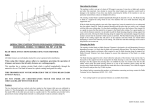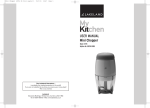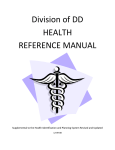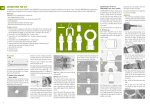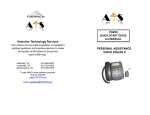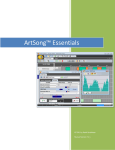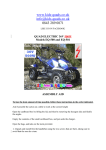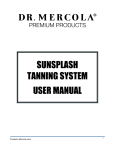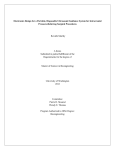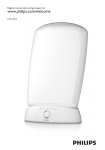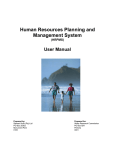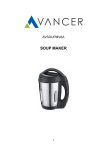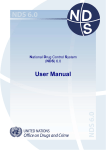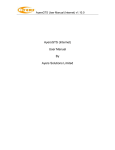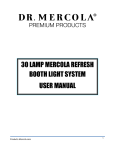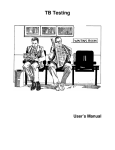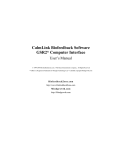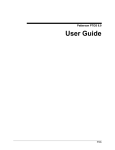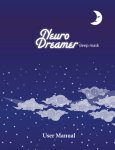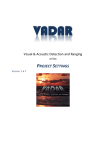Download For Your Geriatric Resident
Transcript
Hartman's Helping in-service educators since 1994! In-Service Education SourceBook Series Caring for Your Geriatric Resident: Based on MDS 2.0 Manual Katherine Vaughn, RN, BSN Caring For Your Geriatric Resident: Guidelines Based on HCFA’s Resident Assessment Instrument MDS 2.0 Manual Contributor Katherine Vaughn, RN, BSN Clinical Instructor, Education Department Cookeville Regional Medical Center The publisher gratefully acknowledges the contributions of the following individuals who reviewed this material: Catherine Van Son, RN, MSN Oregon Geriatric Education Center Oregon Health Sciences University Portland, Oregon Marianna Kern Grachek, MSN, RN, C, NHA Lombard, Illinois Paula S. Ayers, RN, BSN, MS Grand Junction, Colorado NOTICE TO THE READER Though the guidelines contained in this text are based on consultations with healthcare professionals, they should not be considered absolute recommendations. The instructor and readers should follow employer, local, state, and federal guidelines concerning healthcare practices. These guidelines change, and it is the reader's responsibility to be aware of these changes and of the policies and procedures of her or his healthcare facility/agency. The publisher, author, editors, and reviewers cannot accept any responsibility for errors or omissions or for any consequences from application of the information in this book and make no warranty, express or implied, with respect to the contents of this book. Publisher does not warrant or guarantee any of the products described herein or perform any analysis in connection with any of the product information contained herein. CREDITS Contributor: Katherine Vaughn Development Editor: Susan Alvare Copy Editor: Kristin Jandackova Composition: Susan Alvare Illustration: Thaddeus Castillo ISBN 1-888343-35-4 ©2000 Hartman Publishing, Inc. All rights reserved. Limited permission to photocopy the labeled handouts in this text is granted to direct purchasers of this book from the publisher. Copies can only be made for employees or students at ONE LOCATION of a multi-site employer or school. No other part of this book may be reproduced, in any form or by any means, without permission in writing from the publisher. Table of Contents FYI 5 Introduction and Assessment Handouts: Assessment A (8) Assessment A Answer Key (9) Note-Taking Worksheet (10) Key Terms (18) 7 1: Discuss HCFA’s Minimum Data Set (MDS) manual including its purpose and how it is used 20 Handout: Resident Assessment Protocol Summary (21) Transparency: HCFA’s MDS Assessment (22) 2: Name the five levels of Maslow’s Hierarchy of Needs and describe the normal physical changes that occur during the aging process 23 Handouts: Maslow’s Hierarchy of Needs (25) Physical Changes During the Aging Process (26) Transparencies: Maslow’s Hierarchy of Needs (27) Physical Changes During the Aging Process (28) 3: Discuss the differences between delirium, dementia, and forgetfulness, and describe the signs and symptoms for each stage of Alzheimer’s disease 29 Handouts: Delirium (31) Dementia (32) Alzheimer’s Disease (33) Transparencies: Delirium (34) Dementia (35) Alzheimer’s Disease (36) Forgetfulness (37) 4: Describe ways to deal with residents who wander, yell, and exhibit other disruptive behavior as a result of dementia 38 Handouts: Residents Who Resist Care (40) Residents Who Wander (41) Transparencies: Residents Who Resist Care (42) Residents Who Wander (43) Residents Who Yell Disruptively (44) Residents Experiencing Delusions/Hallucinations (45) 5: Name three common causes of impaired vision in the elderly 46 Handout: Causes and Types of Vision Impairment (48) Transparency: Symptoms of Vision Impairment (49) 6: List four ways to facilitate communication with the elderly resident 50 Handout: Communication (52) Communication Techniques (53) Transparency: Communication Techniques (54) 7: Name three complications frequently related to inactivity in the elderly 55 Handout: Complications Associated With Inactivity (57) Transparency: ADLs/Rehab Potential (58) 8: List eight possible causes of urinary incontinence and explain why long-term indwelling catheters are undesirable 59 Transparencies: Causes of Urinary Incontinence (61) Types of Urinary Incontinence (62) Indications for Indwelling Catheter (63) iii 9: Name three signs/symptoms of depression Handout: Signs of Depression (65) 64 10: List five possible causes of angry, agitated behavior and describe ways to effectively deal with this behavior 66 Handouts: Possible Causes of Agitated Behavior (69) How to Respond to Agitated Behavior (70) Music Therapy (71) Transparencies: Key Points About Agitated Behavior (72) Possible Causes of Agitated Behavior (73) Another Approach to the Angry Resident (74) 11: Describe three common factors that contribute to falls in the geriatric resident 75 Transparency: Who’s at Risk for Falls? (76) 12: List three indications that a resident is at risk for malnutrition or dehydration 77 Handout: Factors That May Lead to Malnutrition (80) Transparencies: Feeding Tube Complications (81) Signs/Symptoms of Dehydration (82) Results of Dehydration (83) 13: List three indications that a resident needs a dental consult Transparencies: At Risk for Dental Problems (85) Suspect a Problem if You Notice…(86) 15: Name two possible harmful side effects related to the use of psychotropic medications 93 Transparency: Psychotropic Medications (95) 16: List three alternatives to restraining a resident 96 Handouts: Restraints in Long-Term Care (98) Restraint Alternatives (99) Transparencies: Reasons Cited for Restraint Use (100) Pros and Cons of Restraint Use (101) 17: Discuss ways in which you can help meet the physical, emotional, and spiritual needs of the dying resident 102 Handouts: Needs of the Dying Resident (104) The Dying Person’s Bill of Rights (105) Transparency: Needs of the Dying Resident (106) Closing and Assessment Handouts: Assessment B (108) Assessment B Answer Key (110) 107 References 111 In-Service Evaluation Form 112 Certificate of Completion 113 Record-Keeping Form 114 For More Information 115 84 14: List three interventions for preventing pressure ulcers 87 Handout: Venous vs. Arterial Ulcers (89) iv Transparencies: Risk Factors (90) Pressure Points (91) Interventions (92) FYI The geriatric population (those 85 years old and older) is the fastest growing segment of our population. In 1960, there were approximately 3,000 people over 100 years old in the United States. Today, there are about 60,000 people over the age of 100! The Baby Boomers are beginning to age. Our country’s relatively high level of quality health care has improved longevity. Today’s health care providers need to be prepared to care for this fast-growing population. In 1990, the Health Care Financing Administration (HCFA) published the Resident Assessment Instrument (RAI) User’s Manual for use by Long-Term Care (LTC) facilities. The RAI tool consists of three components: the Minimum Data Set (MDS), the Resident Assessment Protocols (RAPs), and the Utilization Guidelines (check to see if there are state-specific requirements for your area). All three components are covered in detail in the latest version of the RAI, the MDS 2.0. The purpose of the manual is “to facilitate accurate and effective resident assessment practices in long-term care facilities.” The tool helps staff gather data on a resident’s strengths and needs “which must be addressed in an individualized care plan.” HCFA further states, “As the process of problem identification is integrated with sound clinical interventions, the care plan becomes each resident’s unique path toward achieving or maintaining his or her highest practicable level of well-being.” This in-service is intended to help LTC nursing assistants better care for residents based on the MDS guidelines. Each learning objective corresponds with one of the eighteen RAPs (categories) with an added section on the needs of the dying resident. (Note: In this in-service, their psychosocial well-being, mood state, activities, and feeding tube categories are covered under various other RAP topics.) The standards of care presented in the inservice apply to home health aides as well. While nursing assistants do not document on the RAI tool itself, their input is invaluable to the members of the care plan team who do assess, plan, and document care. The MDS cannot be completed accurately without input from the nursing assistant. Different LTC facilities assign varying tasks and responsibilities to nursing assistants. Some of the information included in the inservice may not apply to your organization. For example, your facility may not feel it necessary to cover psychotropic medications; however, this section has been included in an attempt to raise awareness and to further educate nursing assistants. Increased knowledge tends to yield increased understanding, cooperation, teamwork, and, ultimately, better care. You may find it helpful to augment some or all of the learning objectives with the corresponding section of the MDS manual. In recent years, much has been learned about caring for the elderly. There is much more to be discovered. HCFA, clinicians and researchers will continue to evaluate and fine-tune the delivery of LTC services to “incorporate state-of-the-art changes in clinical practice and assessment methodologies, as well as accommodate the For Your Information 5 changing needs of the nursing home population.” Please note that limited permission is granted to photocopy the handouts for use at the site originally purchasing this in-service. Photocopying other parts of this in-service, including the lesson plan, is expressly prohibited. To use the handouts, photocopy the number needed for your group. Consider using different colors of paper to organize the different handouts or to make some stand out. Convert transparency masters to acetates for use with an overhead projector. You can do this by purchasing transparency film at an office supply store and photocopying the transparency masters onto the acetates, or you can have a copy company do it for you. If overhead projection is not convenient for your presentation area, you may wish to copy the information from the transparency masters onto a chalkboard or flip chart. We hope you find this in-service helpful. And, as always, we welcome your comments and suggestions. Happy Teaching! Please read. You may notice that we are employing a new design in this SourceBook. We have replaced certain written instructions with symbols to help guide you through the Lesson Plans. Following is an explanation of the new symbols. = estimated time it will take you to complete a Lesson Plan = suggested tools to help you teach that Learning Objective = distribute the indicated Handout = display the indicated Transparency 6 For Your Information Introduction and Assessment 15-20 minutes Handout Intro-1 Assessment A Handout Intro-2 Assessment A Answer Key Handout Intro-3 Note-Taking Worksheet Handout Intro-4 Key Terms Handout Intro-1 Assessment A To reduce test anxiety, explain to participants that the pre-assessment serves to give them an idea of what will be covered in the in-service and to stimulate thinking. Also, emphasize that the pre-test score will not be used against them, but rather it will be used to help the instructor better meet participant needs by focusing on areas that may not be well understood. Allow participants enough time to finish the assessment. Go over the answers and discuss. Handout Intro-3 Note-Taking Worksheet Tell participants to take notes on the worksheet during all the lectures and discussion. This will help them learn and retain the information and provide them with a review of the in-service later on. Tell participants to keep this handout and read over it. Handout Intro-4 Key Terms Introduction and Assessment 7 Assessment A Name: Date: True or False. For each of the following statements, write “T” for true or “F” for false. 1. ___ HCFA’s Minimum Data Set (MDS) manual was developed by the federal government to help long-term care facilities deliver quality care to residents. 2. ___ Developing thicker, tougher skin is a normal part of aging and is frequently seen in elderly residents. 3. ___ Dementia can be reversed in elderly residents who are motivated to get better. 4. ___ If a resident’s wandering is harmless, it should be allowed to continue. 5. ___ Residents with diabetes have a higher risk of developing problems with vision. 6. ___ Touch, body language, tone of voice, and facial expression are more powerful than words. 7. ___ If there is a chance your resident could fall, do not allow them to get out of bed. 8. ___ Urinary incontinence is always incurable in elderly residents. 9. ___ Insomnia or a change in sleep pattern are signs of depression. 8 10.___ Agitated behavior in the elderly may be caused by tranquilizers or other medications. 11.___ The use of trunk restraints can contribute to falls. 12.___ Residents who are given a pureed diet are at risk for developing malnutrition. 13.___ Constipation and fever can signal dehydration. 14.___ Residents with a history of long-time alcohol or tobacco use are not at an increased risk for dental problems. 15.___ Proper nutrition and hydration are not as important in preventing pressure ulcers as turning the resident every two hours. 16.___ If a resident suddenly becomes combative, you should immediately suggest to the nurse that the resident needs tranquilizing medication. 17.___ In order for me to give the best possible care to a dying resident, it is important for me to be aware of my own feelings and attitudes about death. Handout Intro-1 Assessment A Answer Key 1. True. 10. True. Many, many medications can cause agitation, including the medications used to treat agitation. 2. False. The skin becomes thinner with age. 3. False. Dementia is a chronic, progressive illness of the brain for which there is no cure. 4. True. Many residents wander harmlessly and may even become combative, agitated, or bed bound if forced to stop (as with restraints). 11. True. Trunk restraints can contribute to other injuries as well such as strangulation and broken bones. 12. True. Any mechanically altered diet contributes to this risk. 13. True. These signs should always be reported. 5. True. Blindness and impaired vision are often related to diabetes. 14. False. 6. True. It is generally accepted that nonverbal communication is more powerful than words. 15. False. Good nutrition and hydration are essential to help prevent and heal existing pressure ulcers. 7. False. A certain amount of risk must be accepted if residents are to be assisted with maintaining or improving ADL function. 16. False. Alternative treatment should be explored first, with the focus on determining the cause of the behavior, especially if the behavior is new or sudden. 8. False. Urinary incontinence is curable in many elderly residents. 9. True. 17. True. While we should never force our own feelings on the resident, it is important to be aware of our attitudes and beliefs. Handout Intro-2 9 Note-Taking Worksheet Name: Date: 1-1 Name three components of HCFA’s MDS assessment tool. 1. 2. 3. 2-1 List five needs in Maslow’s Hierarchy of Needs theory. 1. 2. 4. 5. 3. 2-2 Describe two normal physical changes that occur during the aging process in each of the following body systems. Integumentary 1. 2. Musculoskeletal 1. 2. Nervous 1. 2. Circulatory 1. 2. Respiratory 1. 2. Digestive 1. 2. Urinary 1. 2. 3-1 Define delirium and list nine possible causes. Delirium is Causes include: 1. 2. 3. 4. 5. 6. 7. 8. 9. 10 Handout Intro-3











